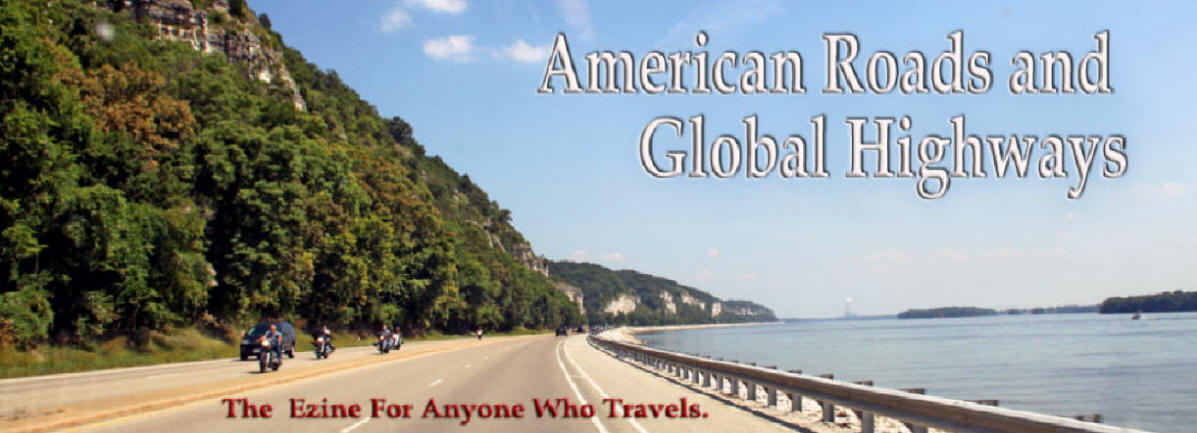
Book
Lovers
Get free books and insider scoops on new releases.
No spam.
Start with your free copy of
Musings: Authors do it Write!
|
Published 3-26-2021
We'd love to have you
share our stories on Social Media.
    |
This is a trip for a pandemic, one
that minimizes crowds and is mostly out-of-doors. The highest
point in any state offers a destination with a view. A day
trip from my location offered three choices in North Carolina
(highest in eastern United States), South Carolina, and
Georgia. Georgia won, as it includes a museum and a view of
the Atlanta skyline from 80 miles (on a very clear day, not
the day I was there). On regular clear day, four states should
be visible. The name of the top attraction is Brasstown Bald.
The state historical marker gives
the derivation of the name from the Cherokee language, meaning
green place, and notes an early White settlement of Brasstown
nearby. North Georgia is the southern end of the Appalachian
Mountains and this is part of the Blue Ridge Mountains. Matter
of a fact, the Appalachian Trail begins about 25 miles to the
southwest. You can drive nearly to the top of Brasstown Bald
and a shuttle will take you the last half mile or so to the
very top. Be careful, the shuttle sometimes does not run on
weekdays. On those days you can walk the 0.6 miles to the top
on a paved trail. Warning: most people would not enjoy the
walk up to the top; it is very steep. The walk down is great,
with lots to see.

What exactly is a bald? Balds occur
mainly in the southern Appalachian Mountains on mountain
summits below the treeline (usually at elevations from about
4,000 to 6,000 feet) and would be expected to be forested.
Instead, they are treeless (bald) grassy meadows. Balds in the
northern Appalachian Mountains occur above the alpine zone
where trees do not grow due to the short growing season. In
the southern Appalachians, even the highest elevations are too
warm for an alpine zone, so balds are unexpected.
The cause of balds is actually a
mystery. One theory is that Cherokee Indians cleared land and
burned vegetation to provide lookouts, camps, and hunting
areas. Another explanation is that European settlers cleared
these flat areas for farming and pasture. Still another theory
points to natural causes. Elevation, severe climate, and fire
may combine to produce and maintain the balds. For a
discussion of theories on their origins see the National Park
Service publication on grassy balds in the Great Smoky
National Park in the additional information.
Heath shrub species like
rhododendron and mountain laurel are the main plants growing
on these balds. These plants thrive on high rainfall and
humidity, low soil and air temperatures, and soils that are
acidic and nutrient-poor. Prevailing winds and low
temperatures create extreme conditions in the winter. Harsh
weather stunts and deforms the trees as the altitude
increases. Certain plant species disappear as you proceed up
the mountainside to the bald. Even on the short walk from the
parking lot to the tower, you can observe this change in plant
species.
Helen, Georgia is a Logical
Starting Place
A top tourist attraction in Georgia
is Helen, a tourist town modelled on a Bavarian alpine
village. It is a destination village, but not the topic of
this article. I mention it as it is a logical starting point
to see the top attraction in elevation, 3,000 feet higher than
Helen. October is one of the best times to visit Helen for
Octoberfest, and also a wonderful time to visit North Georgia
for the leaves. Brasstown Bald is on the Russell-Brasstown
Scenic Byway that winds through the Chattahoochee-Oconee
National Forest in a 40-mile loop. The loop begins just north
of town, go north on Main Street, and includes scenic
overlooks, waterfalls, interpretative signs, and Brasstown
Bald.

Helen, Georgia is a destination
tourist attraction, an "alpine Bavarian" village, and one of
many places to access the Russell-Brasstown Byway

While Helen is not the topic, to point
out potential locations to eat or drink near the Byway, this
is a beer garden and restaurant
on the Chattahoochee River, in the center of town.
The Russell-Brasstown National
Scenic Byway winds through the mountain gaps of North Georgia
offering scenic overlooks and vistas. At Hog Pen Gap is a
picnic area where the Appalachian Trail crosses the Byway. It
is an opportunity to hike a few yards on the Appalachians
Trail, just to say you've been on it. Waterfalls, at least to
me, are the most interesting stops on the Byway. There are
lots of waterfall options, some with paved trails and others
with a couple of miles of hiking and some slopes. Close to
Brasstown Bald is High Shoals Falls, 1.2 miles in and 1.2
miles back. It is an easy hike in and not so easy back, as
back is mostly uphill.
The trek to the falls is through a
lush old growth forest, with many exceptionally large trees.
The trail is a little rough, but easy to follow, with plenty
of mountain laurel in the understory and thickets of
rhododendron. About halfway to the falls, a bridge crosses
High Shoals Creek and the trail follows the creek from there
on. Generally, you can hear the roar of rushing water for the
next half mile (reminding me of the background soundtrack of
Deliverance). Near the destination a side trail heads to the
creek, leading to Blue Hole Falls. A little farther on the
main trail is High Shoals Falls. Towards the end of the trail
the vegetation turns lush and green, deep in the valley it
looks a bit like a temperate rain forest. It's a wonderful
hike, with a twofer in the middle.
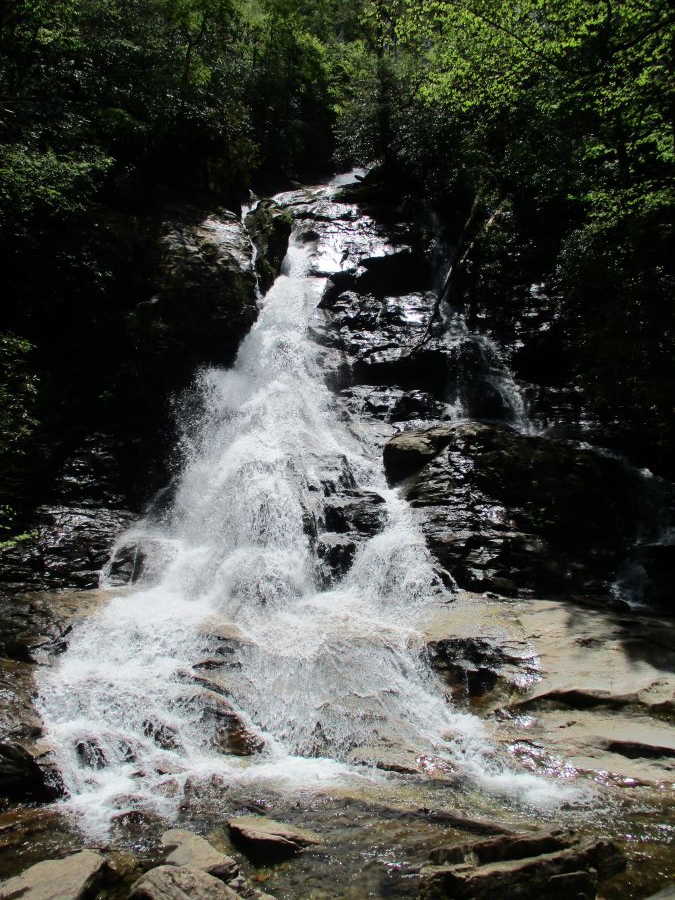
High Shoals Falls, one of many waterfall options along the
Byway.

Not
all trails are paved on the National Forest. Some are rough.
But all have fascinating nature right at their sides.
Brasstown Bald
The road up to Brasstown Bald is
steep, with enough elevation change to produce easily
noticeable changes in vegetation. At the parking lot is a
well-stocked gift shop, including drinks and snacks. At the
top is a large observation tower allowing for a 360-degree
view. The tower contains a fascinating museum with background
on local history, natural features, and a few things for the
kids.

The
observation tower at the top, with museum and a 360-degree
view.
The bald is surrounded by the
Chattahoochee-Oconee National Forest, so very little of the
view from the observation tower shows civilization. You will
have no problem seeing four states, at least on a clear day,
and there are telescopes available if you need help. On some
days you will peer down on cloud tops, or even better,
fog-filled valleys. There is usually a haze, bluish, as you
are in the Blue Ridge Mountains. On some days (in late
September and October) Atlanta is visible, 80 miles away and
3,700 feet lower.
Expect weather conditions that
differ from the rest of Georgia. Fog, mist, and storms can
suddenly move in, obscuring the view. However, those same
weather conditions contribute to the great variety of plants
and wildlife on the slopes of the bald. Temperatures on
Brasstown Bald are usually 5-10% F cooler than the surrounding
areas, making summer a great time to visit. The seasons, of
course, affect the experience. Springtime offers beautiful
displays of blossoming mountain laurel, rosebay, purple
rhododendron, and flame azaleas, which typically bloom between
late May and late June. As you'd expect, the busy season is
fall, when autumn colors spread across the Blue Ridge
Mountains. Peak fall colors occur in mid-October.

Mountains
spreading to the Georgia horizon.

Some views have a little more details on the surrounding
civilization; if you look hard you can make out a city or
lake.
The Visitor Center or museum covers
the rich history of the North Georgia Mountains, both human
and natural history. The impact of the Cherokee Indians and
the early settlers on the land is covered. One display
presents one of the first forest rangers in the Blue Ridge
Mountains who discusses the role of the Forest Service in the
reforestation of the mountains in the early 1900s. There is
also a good bit of logging history and quite a few exhibits of
locally-produced craft objects.

The cultural history starts out with the earliest
inhabitants.

A
life-like robot of forest ranger Arthur Woody, one of the
first rangers in the Blue Ridge Mountains.
He discusses the
role of the Forest Service in reforesting the Appalachian
Mountains and how wildlife populations were reestablished.

Local wildlife is on display. While this is a mounted bear,
there are plenty of signs warning what to do if you run into a
live one on the trail.
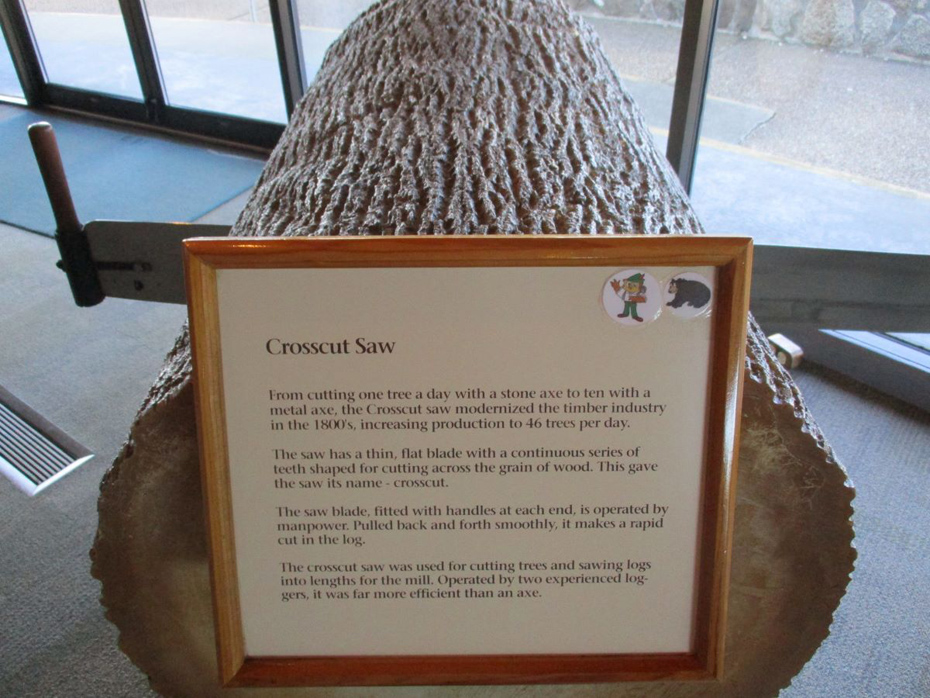
The logging history of the area is part of the museum.
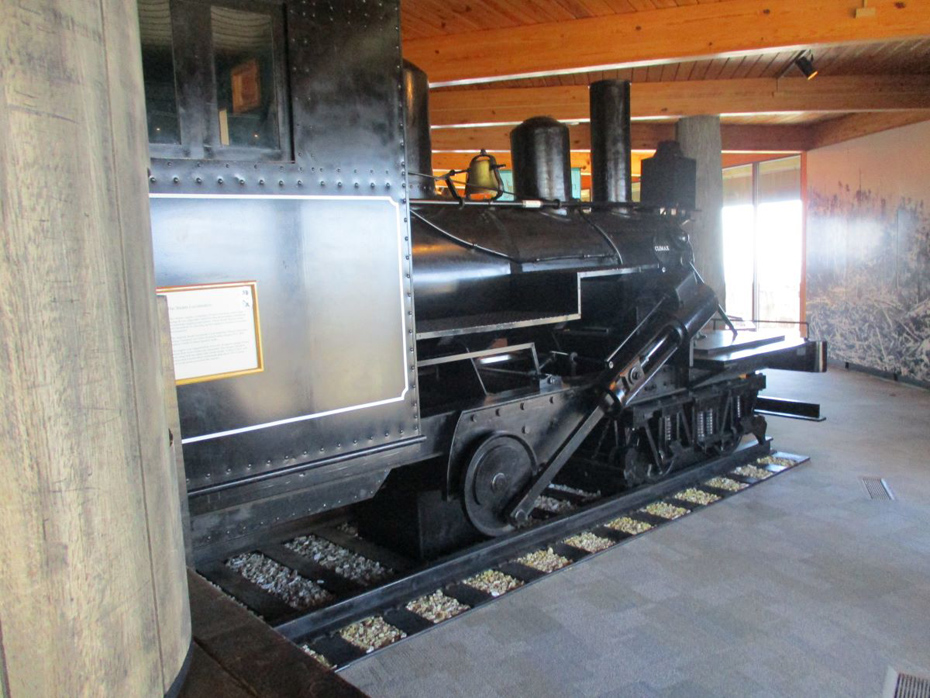
The
Climax logging steam engine, weighing 52 tons, was slow,
noisy, and strong. It was well-suited to the demands of
mountain logging.
There is a wide range of mountain
plants as you descend to the parking lot on a paved trail.
Signage points out interesting forestry and natural
background, like how a watershed works, what happened to the
American Chestnut, and the type of showy shrubs to look for in
the forest. If you look beyond the signs, you can see other
interesting natural things; for example, a tree growing out of
a rock. There is even an old historic wagon train trail.

The entire trail from the parking lot to the observation tower
is paved. However, that only makes the trip up only slightly
easier.

Interesting nature right on the trail; can a tree grow out of
a rock?
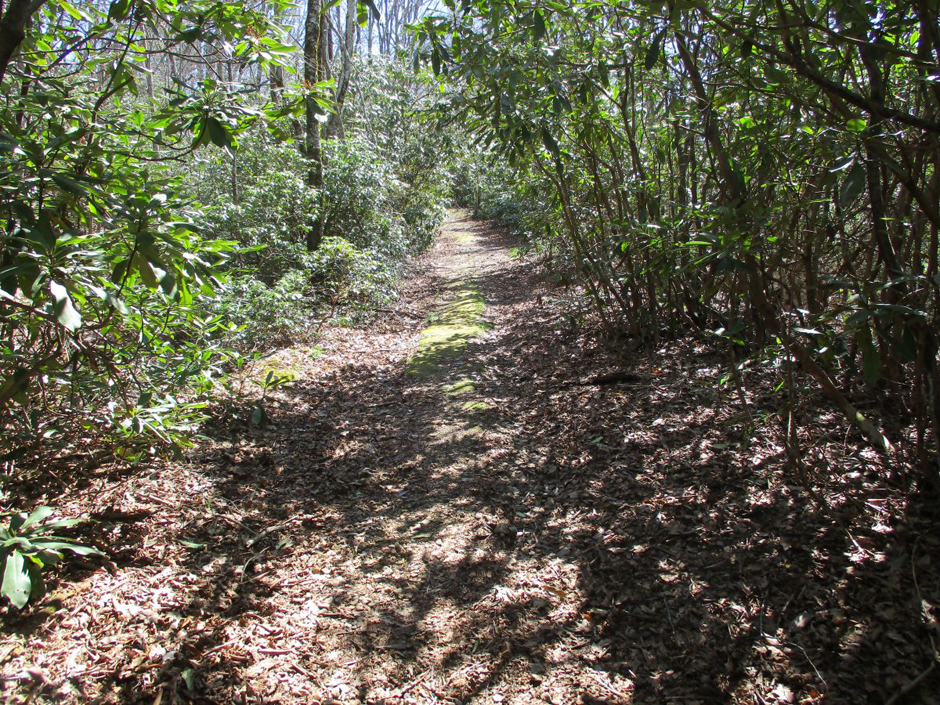
An old historic wagon trail bisects the paved trail. At one
time this was the "main highway." Now it is only open to
hikers.
Brasstown Bald can easily be a
whole day adventure. The National Scenic Byway offers many
side trips, especially the waterfalls. If you plan it right,
Helen can be a midway stop with bratwurst for lunch, and then
quickly back on the byway. The only real planning necessary is
the weather, as you definitely will be outdoors.
Author: Thomas J. Straka is a
forestry professor emeritus at Clemson University. He has a
keen interest in political and natural history.
For additional information:
https://www.fs.usda.gov/recarea/conf/recarea/?recid=82764
https://www.fs.usda.gov/recarea/conf/recarea/?recid=10542
https://www.fs.usda.gov/detail/conf/home/?cid=fsm9_029190
https://www.nps.gov/parkhistory/online_books/grsm/4/intro.htm
We'd love your comments!
|
American Roads
and
Global Highways has so many great articles you
may want to search it for your favorite places
or new exciting destinations.
 |
The
Tenant from Hell
Book 1 in
the Realtor Mystery Series
Casey Clark,
property manager, is
just trying to evict
a bad tenant.
Instead she is over
her head in murder
and mayhem |
 |
Double
Duplicity
Book 2 in the Realtor Mystery
Series
Trouble follows
Casey like a raging
fire. |
 |
Missing--
Gone but not Forgotten
Based on the unsolved
abduction of a little girl in a
rural Florida community |
 |
Under
a Bloody Flag
Kansas and Missouri were a "no man's land" in the days before the War between the States.
|
 |
Under a Black Flag
Kansas and Missouri heated to the boiling point during the War between the States.
|
 |
For
Want of a Ship
John Roy came to New Orleans
looking for peace
instead he found a war. |
 |
Last Step
Last Step will keep
you on the edge of
your seat and leave
you gasping in
surprise at the
ending |
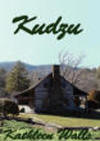 |
Kudzu
Kudzu shows you
a different part of the South, past and present. Mystery with a touch of romance and a smidgen of paranormal.
|
 |
Wild about Florida:
South FL
The Everglades
swarm with wildlife
from birds, to
mammals, to
reptiles. Take a
boat ride into the
surrounding waters
of the Atlantic or
Gulf of Mexico, you
will find dolphins
dancing in your
wake. |
 |
Wild about Florida:
Central FL
Central Florida has
the ocean and gulf
beaches much like
other parts of
Florida but in many
other ways it is
distinct and unique.
The Florida scrub
jay, a bird many
Floridians believe
should be our state
bird, is found
nowhere else in the
world . |
 |
Wild About Florida:
North FL
Come explore caves,
hills, whitewater
falls and lots of
other fun things you
didn't expect to
find in Florida.
North Florida still
lets you enjoy the
sun and sand of Gulf
and ocean beaches,
but there is so much
more. The northern
counties are
different from their
southern and central
counterparts. |
 |
Georgia's
Ghostly Getaways
Who is not
fascinated by
mysterious things
that go bump in the
night? Who has never
wondered about that
thin line that
separates the living
from the dead? Are
there some places
where departed souls
still linger? |
 |
Hosts With
Ghosts
The
South has long been
famous for its
Southern
Hospitality. Hotels
throughout Dixie vie
with one another to
offer their guests
more service and
more amenities. They
strive to make each
visitor feel like a
cherished family
member instead of a
paying customer.
Many have guests
that never depart.
|
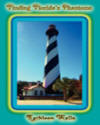 |
Finding
Florida's Phantoms
Florida! The land of
sunshine and
wide-open beaches.
But even the
Sunshine State has
its dark secrets.
Places where
centuries old
spirits remain tied
to earth. Beneath
the facade of fun
and make believe
lurks the real
Florida. |
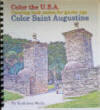 |
Color Saint
Augustine
This is a way to
virtually visit
Saint Augustine.
It's a coloring book
for grown ups (but
kids will love it
too.) It's a spiral
bound, letter size
(8.5" x 11") book
with an actual photo
taken by me of one
of the attractions
in Saint Augustine.
The opposite page is
the same photo
converted into a
black and white line
image for you to to
color. It's 64 pages
with 30 photos and
30 pages for you to
color. On each photo
and each color page
there is a little
about the story of
the image . |
|
|
|
|
|
|
|
|
|
|
